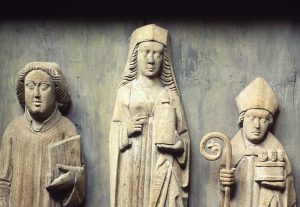Om att praktisera i projektet
2024-02-16
Blogginlägget är skrivet av projektets praktikant Anton Andersson, student vid Göteborgs universitet.
Som studerande på Liberal arts-programmets femte termin ingår ett halvår av praktik. Min praktik blev i forskningsprojektet Mapping Lived Religion. Jag har nu under en hel termin spenderat min tid med att arbeta i projektet. Det har varit en spännande och väldigt lärorik period, där jag har fått använda mig av mina tidigare erfarenheter från mitt program Liberal arts och även fått lära mig nya saker inom projektet.
När jag började med databasen fick jag i framför allt i uppgift att mata in data från medeltida brev från Diplomatarium Fennicum. Detta är något som jag aldrig hade gjort tidigare, och jag hade definitivt inte jobbat med någon liknande databas. Jag hade ett möte med min handledare Terese Zachrisson och Johan Åhlfeldt som programmerar databasen. Jag fick en lärorik genomgång om hur den fungerade och hur allting hängde ihop när olika brev och texter läggs in. I början kändes det som väldigt komplicerat, med många saker att hålla koll på. Men efter att ha jobbat med det mycket i början så kom det ganska naturligt hur det gick till. Jag började lära mig och kunde ta mig an fler brev, och brev som blev mer komplicerade. Jag fick även utanför det försöka mig på att översätta vissa latinska texter till engelska eftersom jag läst flera kurser i latin under mitt program.
Arbetet som jag har fått ta störst del av är att lägga in dessa medeltida brev i databasen. Jag har fått gå in på Diplomatarium Fennicums hemsida för att sedan hitta ett brev som jag fått identifieringsnumret för av min handledare och sedan har jag läst igenom brevet för att lägga in det i databasen och kategorisera de kultmanifestationer brevet innehåller. Jag har också fått försöka hitta vilka personer som finns i breven, vem som har gjort vad, och om det är en t.ex. en donation. Jag har även fått försöka att ta reda på vilken plats brevet är skrivet ifrån osv. I vissa fall fanns det mesta redan inlagt i databasen, så jag bara kunde mata in dem. Men i andra fall kanske inte personen var inlagd och då har jag fått försöka söka mig fram för att hitta till exempel om det var en adlig person i någon känd släkt och vilka föräldrar och barn personen kan ha haft i det fall de förekommit i brevet. Detta gällde även för platser. De vanligaste platserna, som Åbo i Finland, där många brev utfärdats, har redan varit inlagda och jag kunde enkelt mata in dem. Men ibland kunde det gälla mindre sockenkyrkor och då har jag fått ta reda på information kring den här kyrkan, om den finns kvar eller om den har förstörts på något sätt, för att sedan lägga in den informationen i databasen så att kultmanifestationerna kan kopplas till den platsen i databasen.
Jag har även fått ge mig på lite latinska texter som jag fick översätta i början. Jag gjorde några stycken och blev ganska stolt över mina översättningar, men ju fler jag gjorde desto större och mer komplicerade blev de och jag kände att min kompetens från programmet inte riktigt sträckte mig så långt som att översätta källtexter på medeltida latin. Detta eftersom vi till stor del bara har studerat antikt latin från Rom, vilket skiljer sig en del i från det latin som jag skulle översätta från breven. Men det var en rolig utmaning och jag lyckades bra med de kortare texterna. Efter ett tag fann jag dock donationsbreven mer intressanta och jag började bygga upp en mycket större förståelse för de olika viktiga familjerna i framförallt Egentliga Finland och Åland, där jag kunde hitta spännande kopplingar och se deras inflytandet i dessa områden. Jag fick se en vardag inom medeltidens helgonkult som jag aldrig hade fått möjligheten att ta del av om jag inte hade börjat praktisera i detta projektet eller valt att jobba mer med just de här breven.



Recent Comments